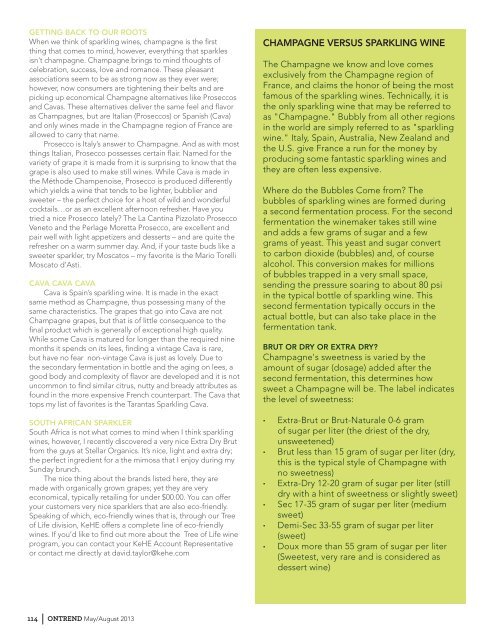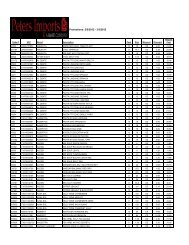Create successful ePaper yourself
Turn your PDF publications into a flip-book with our unique Google optimized e-Paper software.
Getting Back to our RootsWhen we think of sparkling wines, champagne is the firstthing that comes to mind, however, everything that sparklesisn’t champagne. Champagne brings to mind thoughts ofcelebration, success, love and romance. These pleasantassociations seem to be as strong now as they ever were;however, now consumers are tightening their belts and arepicking up economical Champagne alternatives like Proseccosand Cavas. These alternatives deliver the same feel and flavoras Champagnes, but are Italian (Proseccos) or Spanish (Cava)and only wines made in the Champagne region of France areallowed to carry that name.Prosecco is Italy’s answer to Champagne. And as with mostthings Italian, Prosecco possesses certain flair. Named for thevariety of grape it is made from it is surprising to know that thegrape is also used to make still wines. While Cava is made inthe Méthode Champenoise, Prosecco is produced differentlywhich yields a wine that tends to be lighter, bubblier andsweeter – the perfect choice for a host of wild and wonderfulcocktails…or as an excellent afternoon refresher. Have youtried a nice Prosecco lately? The La Cantina Pizzolato ProseccoVeneto and the Perlage Moretta Prosecco, are excellent andpair well with light appetizers and desserts – and are quite therefresher on a warm summer day. And, if your taste buds like asweeter sparkler, try Moscatos – my favorite is the Mario TorelliMoscato d’Asti.Cava Cava CavaCava is Spain’s sparkling wine. It is made in the exactsame method as Champagne, thus possessing many of thesame characteristics. The grapes that go into Cava are notChampagne grapes, but that is of little consequence to thefinal product which is generally of exceptional high quality.While some Cava is matured for longer than the required ninemonths it spends on its lees, finding a vintage Cava is rare,but have no fear non-vintage Cava is just as lovely. Due tothe secondary fermentation in bottle and the aging on lees, agood body and complexity of flavor are developed and it is notuncommon to find similar citrus, nutty and bready attributes asfound in the more expensive French counterpart. The Cava thattops my list of favorites is the Tarantas Sparkling Cava.South African SparklerSouth Africa is not what comes to mind when I think sparklingwines, however, I recently discovered a very nice Extra Dry Brutfrom the guys at Stellar Organics. It’s nice, light and extra dry;the perfect ingredient for a the mimosa that I enjoy during mySunday brunch.The nice thing about the brands listed here, they aremade with organically grown grapes; yet they are veryeconomical, typically retailing for under $00.00. You can offeryour customers very nice sparklers that are also eco-friendly.Speaking of which, eco-friendly wines that is, through our Treeof Life division, <strong>KeHE</strong> offers a complete line of eco-friendlywines. If you’d like to find out more about the Tree of Life wineprogram, you can contact your <strong>KeHE</strong> Account Representativeor contact me directly at david.taylor@kehe.comChampagne versus Sparkling WineThe Champagne we know and love comesexclusively from the Champagne region ofFrance, and claims the honor of being the mostfamous of the sparkling wines. Technically, it isthe only sparkling wine that may be referred toas "Champagne." Bubbly from all other regionsin the world are simply referred to as "sparklingwine." Italy, Spain, Australia, New Zealand andthe U.S. give France a run for the money byproducing some fantastic sparkling wines andthey are often less expensive.Where do the Bubbles Come from? Thebubbles of sparkling wines are formed duringa second fermentation process. For the secondfermentation the winemaker takes still wineand adds a few grams of sugar and a fewgrams of yeast. This yeast and sugar convertto carbon dioxide (bubbles) and, of coursealcohol. This conversion makes for millionsof bubbles trapped in a very small space,sending the pressure soaring to about 80 psiin the typical bottle of sparkling wine. Thissecond fermentation typically occurs in theactual bottle, but can also take place in thefermentation tank.Brut or Dry or Extra Dry?Champagne's sweetness is varied by theamount of sugar (dosage) added after thesecond fermentation, this determines howsweet a Champagne will be. The label indicatesthe level of sweetness:• Extra-Brut or Brut-Naturale 0-6 gramof sugar per liter (the driest of the dry,unsweetened)• Brut less than 15 gram of sugar per liter (dry,this is the typical style of Champagne withno sweetness)• Extra-Dry 12-20 gram of sugar per liter (stilldry with a hint of sweetness or slightly sweet)• Sec 17-35 gram of sugar per liter (mediumsweet)• Demi-Sec 33-55 gram of sugar per liter(sweet)• Doux more than 55 gram of sugar per liter(Sweetest, very rare and is considered asdessert wine)114 OnTREND May/August 2013




